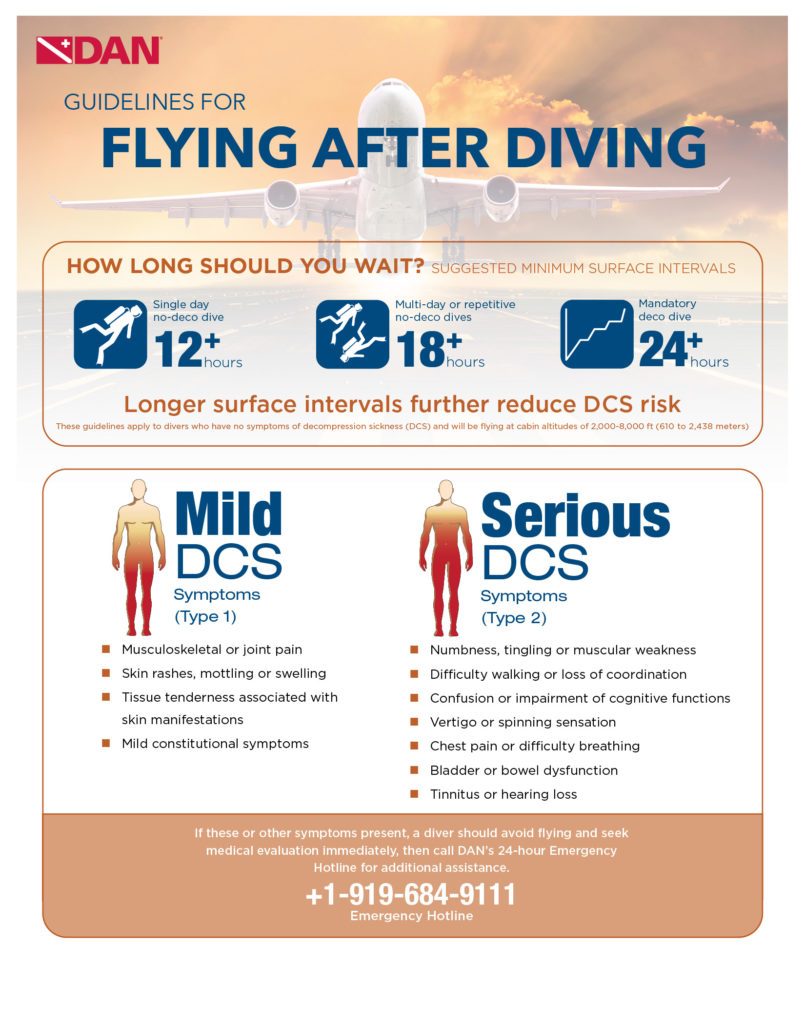When the recommended waiting period before flying after diving was questioned and the lack of evidence governing the guidelines became obvious, DAN designed a series of experiments to provide evidence and establish new, more accurate guidelines for flying after diving. DAN’s initial “Flying After Diving Trials” laid the foundation for the current flying after diving guidelines recognized by the US Navy and followed by recreational divers throughout the world.
This experimental study was completed in 2003.
In the past, guidelines for flying after diving were quite varied. For example, after a single no-stop dive, the U.S. Navy recommended a two-hour surface interval time (SIT), DAN recommended 12 hours SIT and the U.S. Air Force recommended 24 hours SIT. And in 1989, the Undersea and Hyperbaric Medical Society (UHMS) recommended curtailing all diving within 24 hours of a flight and up to 48 hours following a decompression dive.
These guidelines proved to be a serious restriction for divers and dive operators, so in 1991, DAN Researchers developed a series experiments designed to produce the data that was desperately needed to refine these guidelines.
The objective of these studies was to estimate the relationship between the preflight surface interval and decompression illness (DCI) incidence for a few dive series representative of recreational diving. A preflight surface interval was accepted or rejected within the study based upon the number of DCI incidents and total exposures. Acceptance and rejection rules were chosen to allow mild DCI but limit more serious DCI. The Duke Institutional Review Board of Duke Medical Center approved these rules.
With the data collected from these studies, DAN was able to develop more specific guidelines that still reduce the risk of decompression sickness as a result of flying after diving. DAN’s initial “Flying After Diving Trials” laid the foundation for the current flying-after-diving guidelines for recreational divers and then prompted the U.S. Navy to update their residual nitrogen-based flying-after-diving rules.

Additional Reading and References
Articles
Publications
- You can download the following related workshop and conference proceedings in the DAN Publication Library:
- 2002 Flying After Recreational Diving
- Guidelines for Flying After Diving
Peer Reviewed Publications
- Vann RD, Gerth WA, Denoble PJ, Pieper CF, Thalmann ED. Experimental trials to assess the risks of decompression sickness in flying after diving. Undersea and Hyperb Med. 2004; 31(4): 431-444.
- Vann RD, Gerth WA, Denoble PJ, Sitzes CR, Smith LR. A comparison of recent flying after diving experiments with published flying after diving guidelines. Undersea and Hyperb Med. 1996; 23 (supp):36.
- Sheffield PJ. Flying after diving guidelines: a review. Aviat Space and Environ Med. 1991; 61(12): 1130-8.
- Freiberger JJ, Denoble PJ, Pieper CF, Uguccioni DM, Pollock NW, Vann RD. The relative risk of decompression sickness during and after air travel following diving. Aviation Space and Environ Med. 2002; 73(10): 980-984.